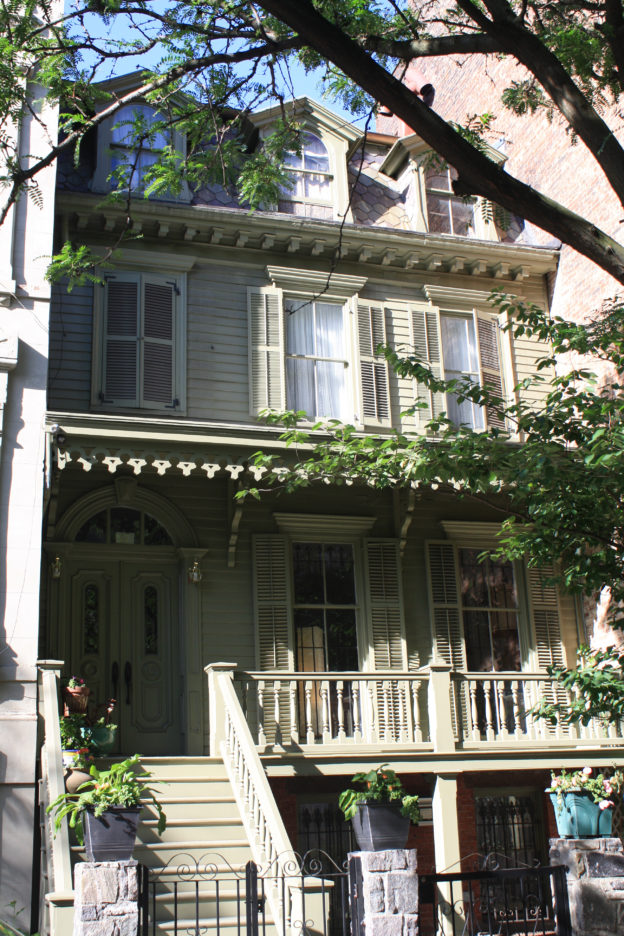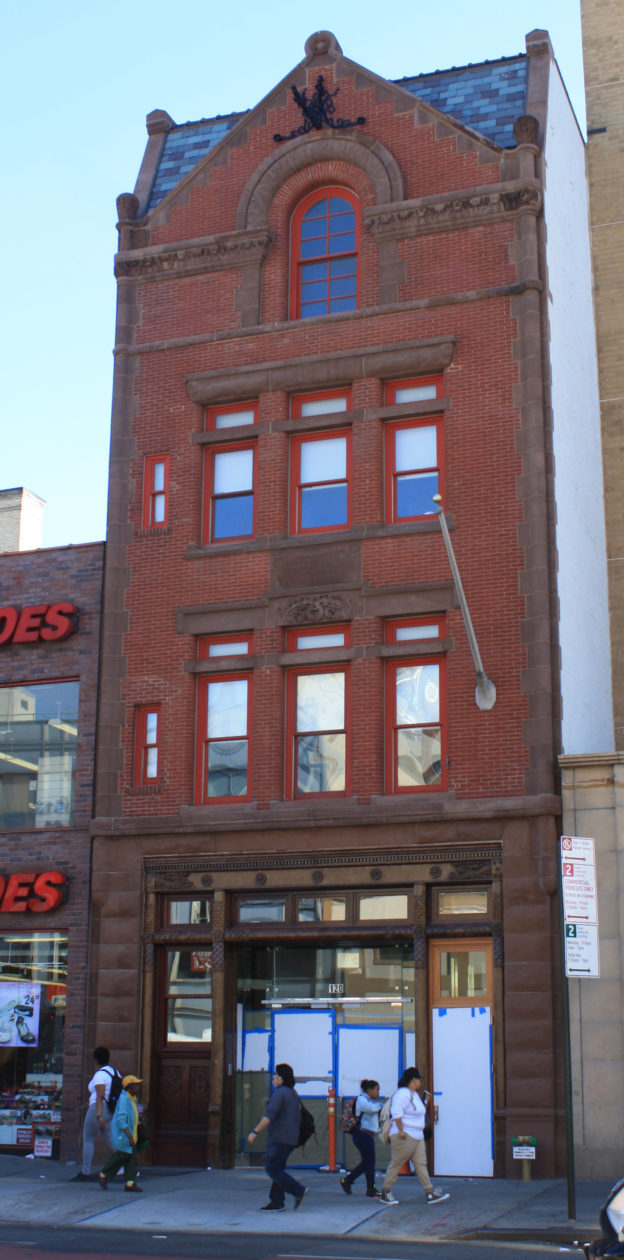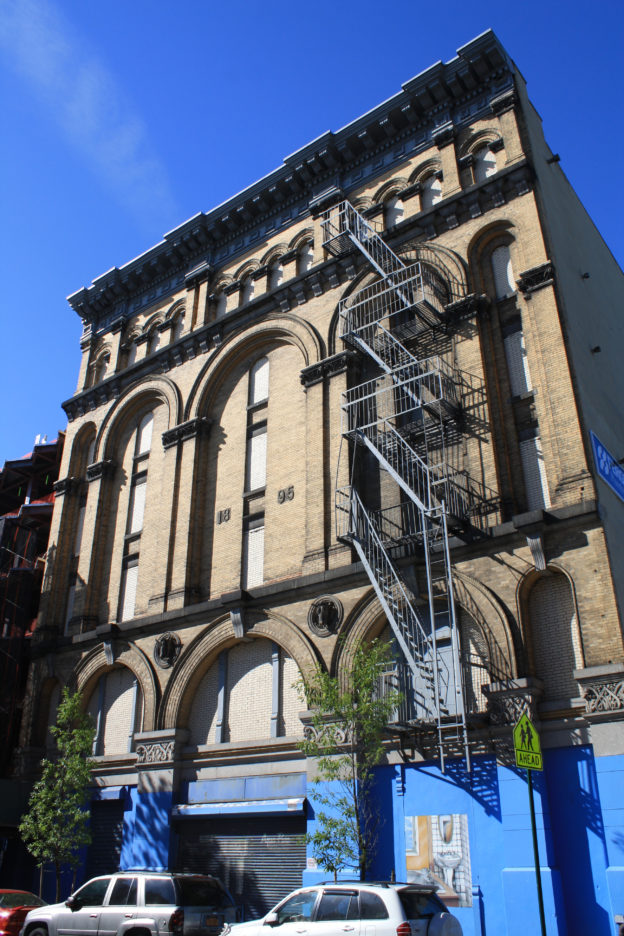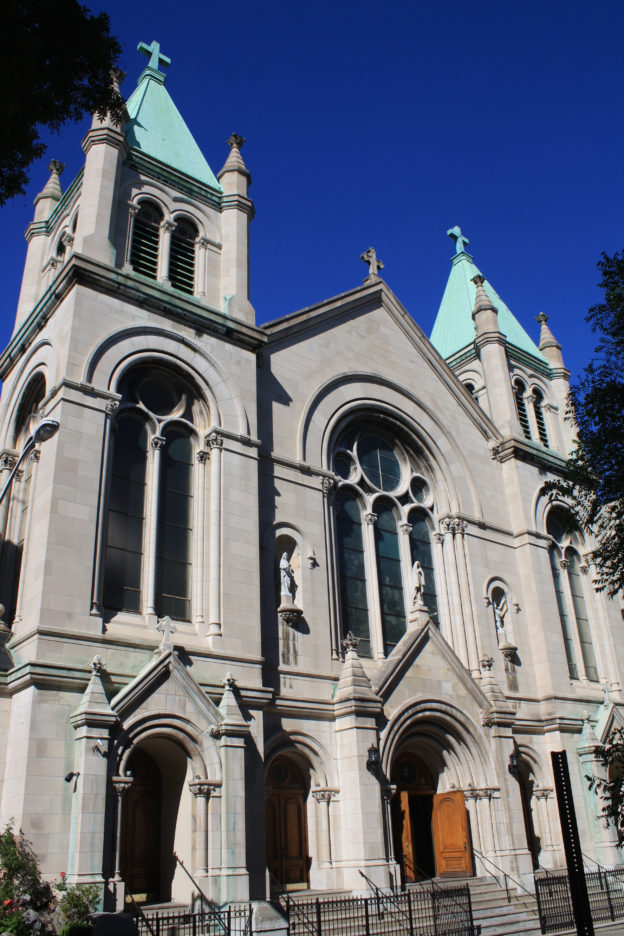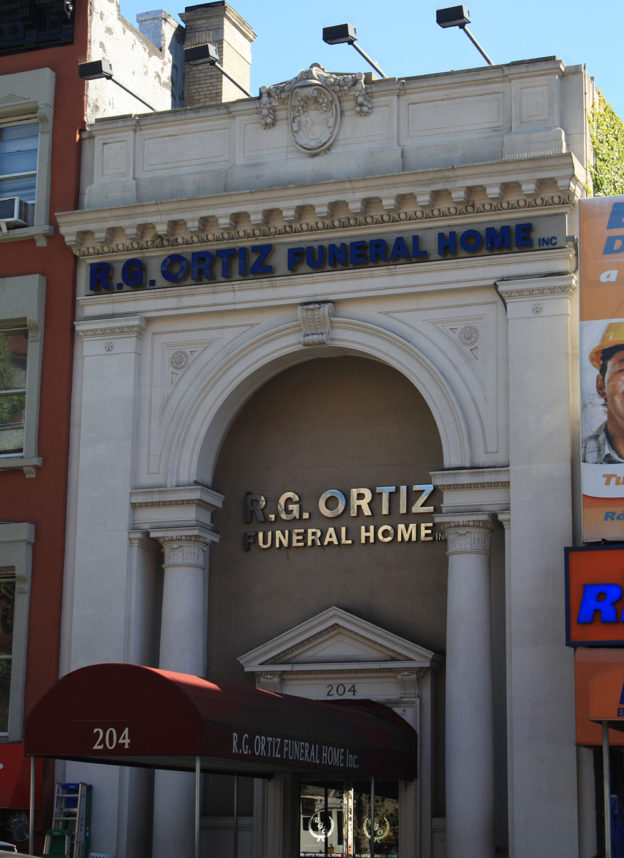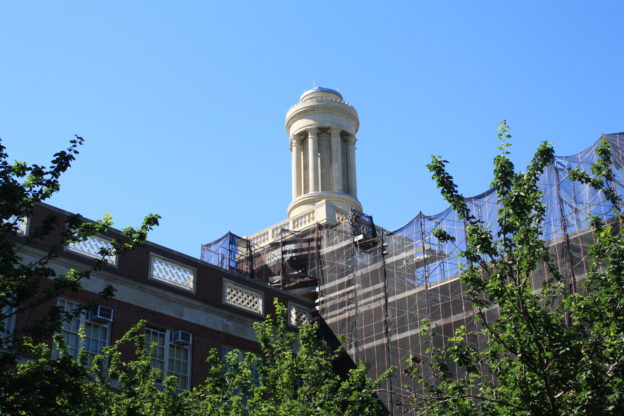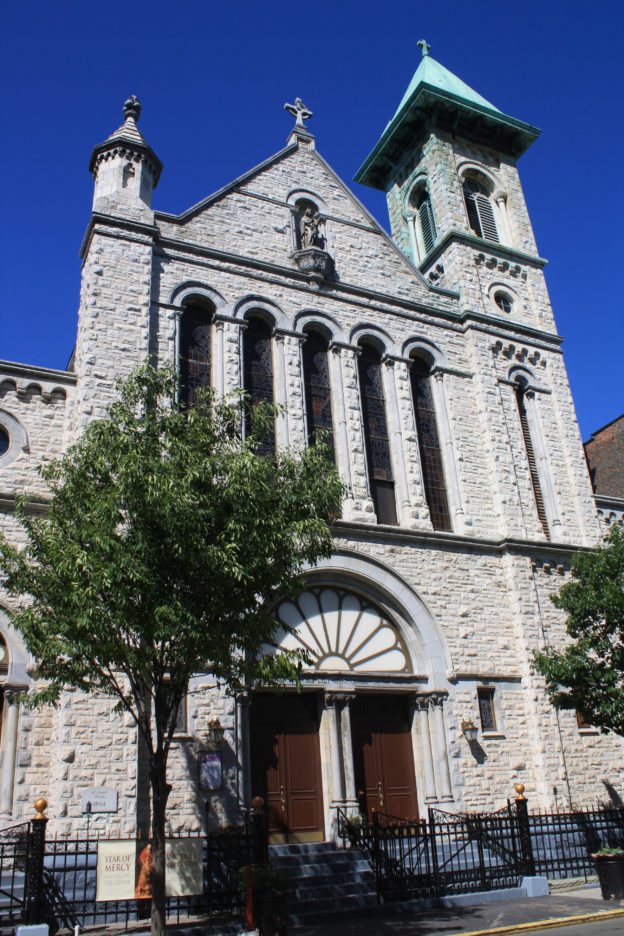c. 1864|
This charming building is one of the few surviving wood frame houses in Harlem, built when Harlem was still a rural village separate from New York City. Designed with Second Empire and Italianate elements by an unknown architect, the house is clad in wood clapboard and features a full-width porch and a slate mansard roof. The house stands as a reminder of Harlem’s early history before being annexed to the city in 1873.
17 East 128th Street is a designated New York City Individual Landmark .
81-85 East 125th Street;
Lamb & Rich;
1883-84; enlarged 1889-90|
Described in the Landmarks Preservation Commission’s (LPC) designation report as “one of the most impressive buildings in Harlem”, the former Mount Morris Bank Building enjoys prominent visibility thanks to its location immediately adjacent to Metro-North’s 125th Street station. The original Queen Anne and Romanesque Revival style building, constructed of brick and sandstone with terra-cotta and iron details, originally housed a bank at the ground level with French flats (later offices) in the upper stories. In 1913, the Mount Morris Bank became part of the Corn Exchange Bank, which operated here until the mid-1960s. The building became vacant in the late 1970s and fell into disrepair, but was designated an individual landmark in 1993. In 2013, the LPC approved plans to reconstruct the building with a design that interprets, rather than recreates, the original structure.
The Former Mount Morris Bank Building is a designated New York City Individual Landmark and listed on the State and National Register of Historic Places.
170 East 121st Street;
Thom & Wilson;
1891-93|
Originally built to house one of the city’s Municipal and Magistrates Courts, this building once contained roughly 40 jail cells. The court was decommissioned in 1961, and the building was transferred to other city agencies. In 2002, it became the Harlem Community Justice Center, where family, housing and small claim civil cases are heard in its third floor courtrooms. The magnificent structure was designed in the Romanesque Revival style with Victorian Gothic details, abounding in colored brick, bluestone and terra-cotta ornament and arched windows. The most striking feature is the bronze spire-capped corner tower, whose octagonal belfry contains gabled arches enframing clock faces on some and circular windows on others. The interior contains two murals painted in 1938 by Works Progress Administration artist David Karfunkle. The murals were covered by drapery and severely damaged until their restoration in 2014.
The Harlem Courthouse is a designated New York City Individual Landmark and listed on the State and National Register of Historic Places.
120 East 125th Street;
Napoleon LeBrun & Sons;
1888-89|
Like Fire Engine Company No. 53 (site #2a), this fire station was designed by Napoleon LeBrun & Sons during their tenure as architects for the New York City Fire Department. In 1975, the Romanesque Revival style building became home to Fire Engine Company No. 36 until it was decommissioned in 2003. As a result of its designation as an Individual Landmark by the city in 1997, the building has continued to thrive, having undergone a restoration and conversion to the Caribbean Cultural Center African Diaspora Institute in 2014-15.
The Former Fire Hook & Ladder Company No. 14 is a designated New York City Individual Landmark and listed on the State and National Register of Historic Places.
207 East 119th Street;
Bartholomew & John Walther;
1895|
This six-story, brick and stone building was constructed for the Webber Meat Market. Richard Webber, an English immigrant, opened his butcher business in 1877 on East 120th Street, expanding with the construction of this imposing building in 1895. Upon his death in 1908, The New York Times described Webber as “one of the largest retail butchers in this city if not in the United States.” The tripartite façade features grand arches, monumental pilasters with Corinthian capitals and a bracketed cornice. Perhaps its most charming feature is a pair of cow head reliefs, evidence of the building’s use, peering down to the street from the second floor.
113 East 117th Street;
Neville & Bagge;
1906-08|
This grand church and school were designed by the noted firm of Neville & Bagge in the Romanesque Revival style of brick clad in Indiana limestone. In addition to commanding a strong presence on East 117th Street, the complex provides an important spiritual and cultural link to East Harlem’s past. The parish of St. Paul’s was established in 1834 to serve the northern reaches of the city, when Harlem was sparsely populated and rural, and bears the distinction of being one of the city’s first Roman Catholic churches. The present structures replaced the earlier church and school buildings, which were located roughly on the same site.
151 East 116th Street;
Henry Devoe;
1870|
Since 1948, Casa Latina has sold sheet music and instruments to patrons from all over the city. In addition to being the longest-running music store in East Harlem, it also bears the distinction of being the nation’s first Spanish-language music store. Its founder, Bartolo Alvarez, was a Puerto Rican musician and record executive. The business moved to this location in 1962 and its colorful storefront has been a neighborhood icon and an important meeting place ever since. The building in which the store resides was built in 1870 as one in a row of brownstones, and has been heavily altered over the years.
204 East 116th Street;
C. P. H. Gilbert;
1923|
Presently the R. G. Ortiz Funeral Home, this handsome structure was originally the Italian Savings Bank, whose name was engraved in the limestone façade where the funeral home’s name is now located. The building, which has undergone some alterations, was designed by noted architect Cass Gilbert, whose many commissions include the Woolworth Building in Lower Manhattan. The former bank, resembling a triumphal Roman arch, stands as one of many reminders of East Harlem’s formerly sizable Italian immigrant population.
280 Pleasant Avenue;
Eric Kebbon;
1940|
This stately building was originally constructed by the NYC Board of Education after designs by Eric Kebbon, architect and superintendent of school buildings from 1938-51. The school was founded by educational theorist Leonard Covello, the nation’s first Italian-American high school principal, who believed in a community-centered approach to learning and the importance of integration and bilingual education. Covello devoted his career to improving the lives of immigrant children, and the school, which hosted a large number of Italian immigrants and subsequently Puerto Ricans, became an important touchstone for his theories. In 1945, Frank Sinatra famously visited the school after a race-related incident broke out between groups of African American and Italian-American students. To ease tensions, Sinatra, one of the country’s most famous Italian-Americans, performed the reconciliatory song Aren’t You Glad You’re You? The school closed in 1982 due to poor performance, and was transformed into the Manhattan Center for Science and Mathematics, which offers a rigorous curriculum and high graduation rate.
438 East 116th Street;
L. J. O’Connor;
1884|
This Romanesque Revival style church was built for an Italian immigrant congregation, and remains a tangible link to the neighborhood’s Italian heritage. The church is named for the Madonna del Carmine, Protectress of Polla, a town in the province of Salerno that was the hometown of many East Harlem immigrants at the end of the 19th century. Beginning in 1882, the church hosted an annual festival in honor of the Madonna on the street outside the church, with many Italians returning to the neighborhood to celebrate. The event, revived in 2000 after a 29-year hiatus, takes place on the second weekend in August and is held by the Giglio Society of East Harlem, which performs the “Dancing Giglio,” a tradition begun here roughly 125 years ago. The celebration serves an important reminder of East Harlem’s Italian heritage.

